Did you know that there are twenty different species of geese across the globe? From those that you may be more familiar with, such as the Canada goose, to the rare nēnē, there is no shortage of unique species. Below, learn what makes a goose a goose, as well as meet twenty types of geese!
What Is a Goose?
While you learned above that there are around twenty different types of geese in the world, do you know what makes a goose a goose? For many, discerning a goose from a duck or swan can be difficult.
All but one species of goose belongs to the family Anatidae. This family includes almost all waterfowl, including ducks and swans. The one exception to this is the magpie goose, which will be discussed in the list included later. Some of the most common subfamilies in Anatidae that include geese are Plectropterinae and Anserinae.
However, without knowledge of taxonomy, this can be a difficult way to tell geese from other waterfowl. As a result, anatomy can often be the best way to tell geese from ducks and swans. For instance, geese have longer necks than ducks, often having anywhere from one to eight more neck bones than the duck’s sixteen. Geese are also overall longer and heavier than ducks. Then, just as geese are larger than ducks, swans are larger than geese. This includes in terms of length, weight, wingspan, and even neck length!
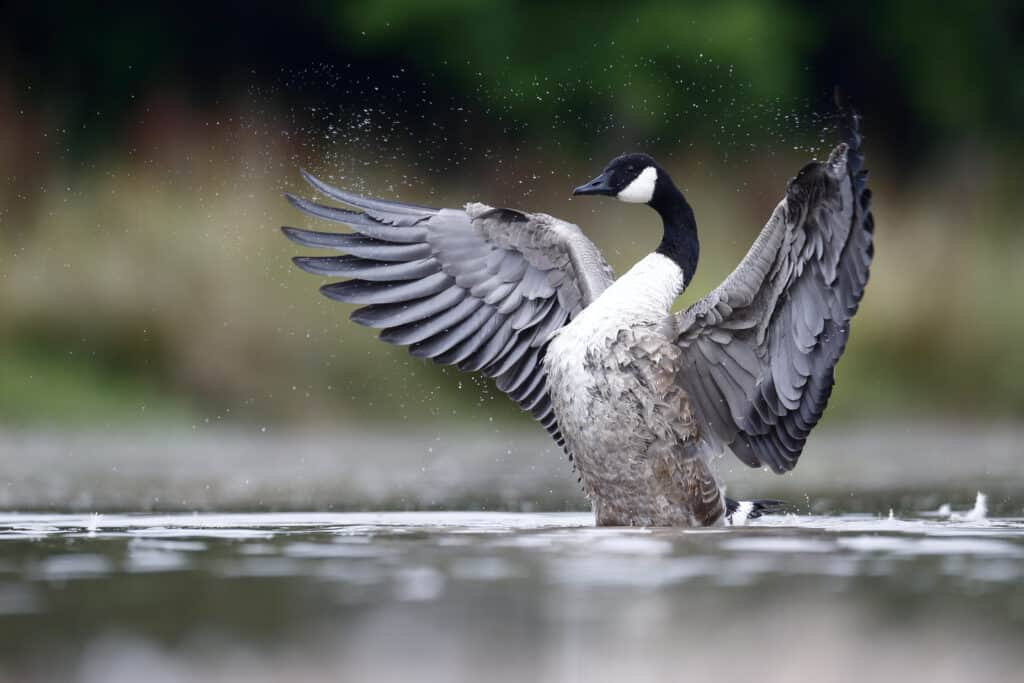
Geese are different from ducks and swans in several ways.
©Erni/Shutterstock.com
20 Types of Geese
Below, take a trip around the world and meet the 20 types of geese you may encounter. This includes where they live, what they look like, and more!
1. Bar-Headed Goose
The bar-headed goose (Anser indicus) is native to Asia, although it has been introduced in Europe. It is a species of Least Concern that can flock together in colonies, reaching thousands of individuals. It breeds in Central Asia and winters in South Asia. During this time, it may settle as far south as India’s peninsula.
This species of goose is named for its white head, which sports two black bars. The larger of these bars encapsulates the back of the head, ending at the eye on either side. The smaller bar is at the nape of the neck and lacks the length of the top bar.
One of the most interesting facts about the bar-headed goose is that they can survive in extreme altitudes. This is essential, as their migration often takes them over the Himalayas. Their bodies are designed to efficiently breathe in and utilize oxygen under these conditions, allowing them to continue exerting energy on flight.
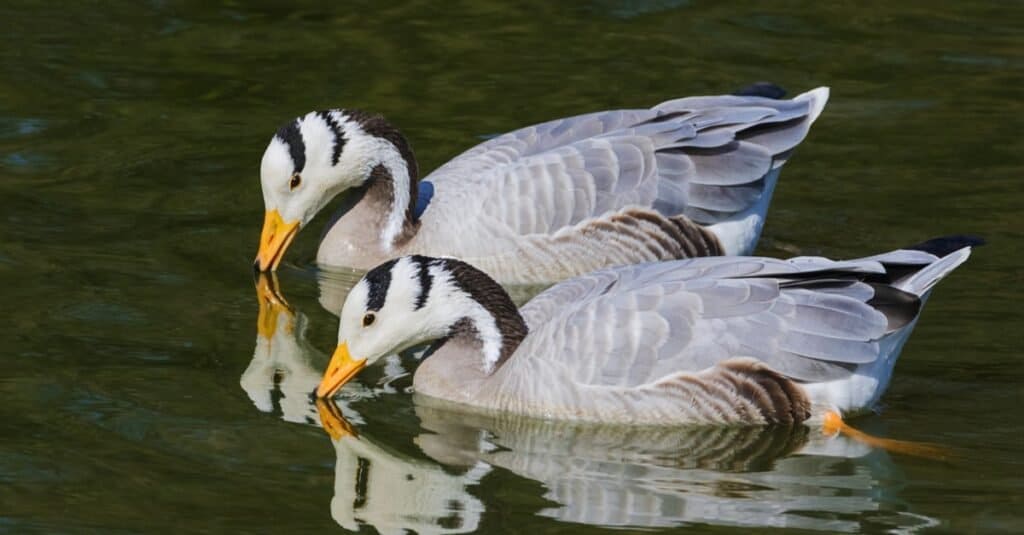
Bar-headed geese are named for their markings.
©Ian Duffield/Shutterstock.com
2. Barnacle Goose
The barnacle goose (Branta leucopsis) sports a primarily black plumage with a notable white mask.
It is named for the barnacle goose myth, which states that these geese were born from goose barnacles, from which they emerged fully formed. This myth also detailed the supposed origin of the brant goose, which will be discussed next. While the barnacle goose may come from an egg rather than a crustacean, they do bear a striking resemblance to the goose barnacle.
Barnacle geese are found throughout much of the northern Atlantic Ocean and the North Sea. They are a compact species of goose, as well as one of the smaller species you may encounter.

Barnacle geese were once believed to come from a crustacean.
©Dennis Jacobsen/Shutterstock.com
3. Brant
The brant goose (Branta bernicla) is also known as the brent goose. Like its relative, the barnacle goose, it is a small, compact species connected to the barnacle goose myth.
There are three different subspecies of this goose. All three of these subspecies breed along the far northern coasts of North America and Europe. They winter further south, along both the western and eastern coasts of the United States, as well as in the coastal regions of the United Kingdom, western Europe, and eastern Asia.
Like the barnacle goose, the brant goose sports a primarily black plumage with white markings.
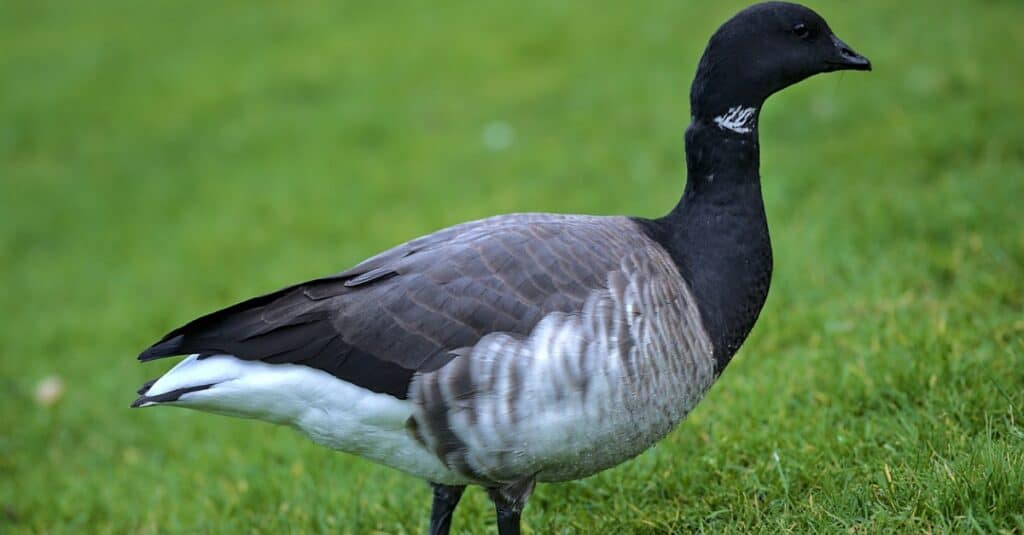
With its small size, the brant may appear more like a duck than a goose.
©iStock.com/Roman Overko
4. Cackling Goose
When you first look at a cackling goose (Branta hutchinsii), you may think it is identical to the Canada goose. While it is true that these two species sport very similar appearance, especially in terms of coloration, there are some key features to help tell them apart. Namely, the cackling goose is far more compact than the Canada goose, with a much shorter neck. They also have a smaller bill and a smaller overall size.
The cackling goose is a species of least concern. They are abundant throughout much of western North America, as well as in the easternmost regions of Eurasia. There are five different subspecies. While they are sexually dimorphic, it is to a lesser degree than other waterfowl species. Females are lighter than males, and they have a different sounding voice.
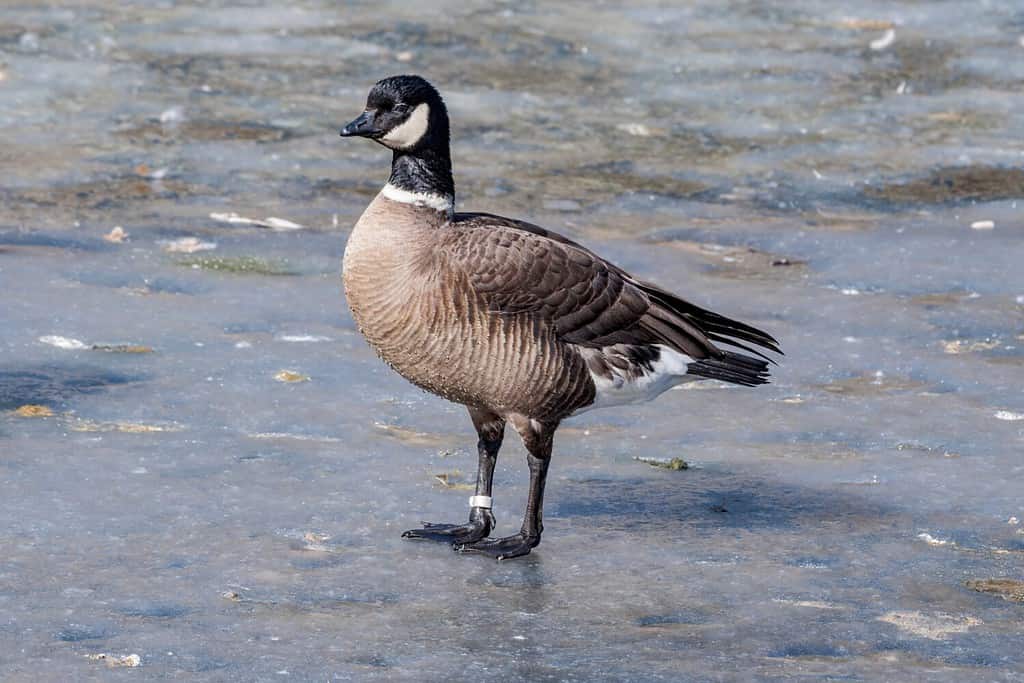
Cackling geese resemble Canada geese but are smaller, with shorter necks and bills.
©Nick Pecker/Shutterstock.com
5. Canada Goose
The Canada goose (Branta canadensis) is also occasionally known as the Canadian goose. It is a rather large species, known for its black head and the white marking on its cheek. They are native to much of North America. However, they have been introduced to Europe, specifically in the United Kingdom, as well as Asia, New Zealand, and South America.
Canada geese are common in human habitats. As a result, you may see them thriving in areas such as parks or near ponds. However, they are also known to be quite territorial. This can lead to aggression towards both humans and other animals. Many areas may consider this species to be a pest due to their noise, aggression, and excrement.

Canadian geese are more temperamental during the nesting season.
©iStock.com/Wayne Marinovich
6. Cape Barren Goose
The Cape Barren goose (Cereopsis novaehollandiae) is a unique-looking species. It is overall gray, with dark markings along their feathers. What is most notable is their short beak. They are a grazing species, and they rarely swim.
Despite being primarily limited to a small area on the southernmost coasts and islands of Australia, the Cape Barren goose is a species of the least concern. They have the ability to drink salt water, and, as a result, they remain offshore all year. They are one of the rarest species of geese in the entire world.
There are two subspecies of the Cape Barren Goose.
7. Emperor Goose
The emperor goose (Anser canagicus) is also known as the beach goose or the painted goose. Their head and the back of their neck are white, while their throat is black. Their body is primarily black with white markings. The International Union for Conservation of Nature lists them as a near-threatened species. NatureServe has them listed as vulnerable.
During the summer, it may be more difficult to identify this species. This is because the white feathers of their head and neck are prone to staining. Because they may often feed in tidal pools with iron oxide, their white feathers may turn orange instead. This coloration may also impact the white feathers of their chest as well.
Typically, they will only mingle within their family. During the breeding season, however, they may form small flocks. They are considered one of the most unsocial types of geese, second only to the brant.
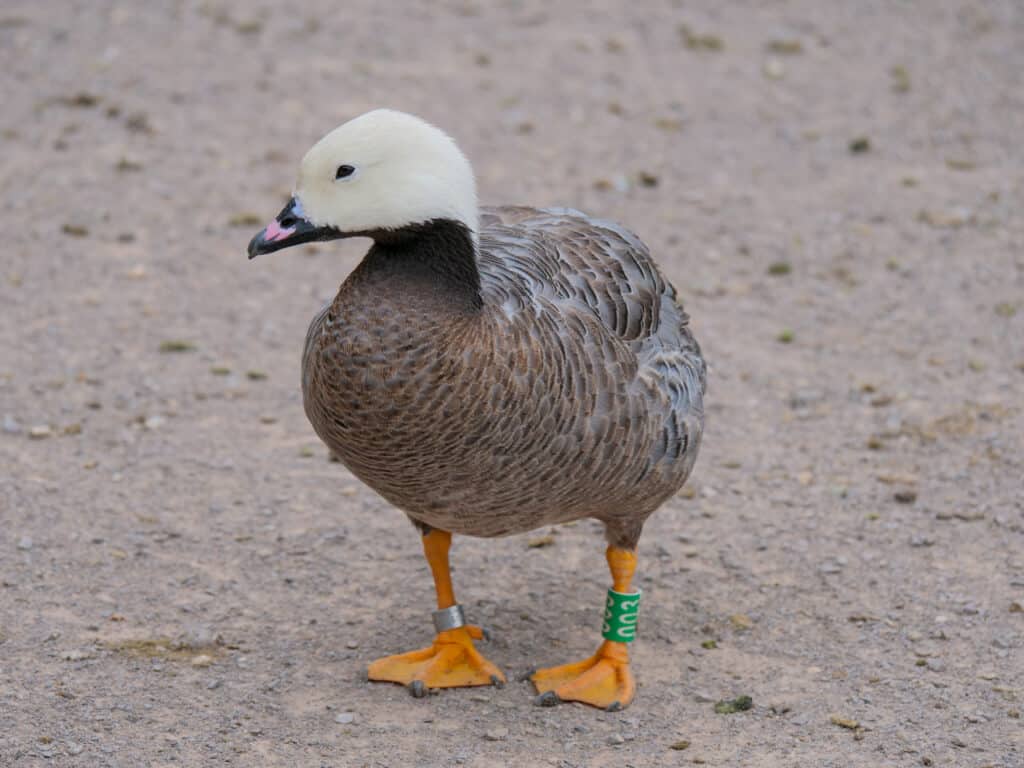
Emperor geese have many names, including beach goose and painted goose.
©iStock.com/Emma Sanger-Horwell
8. Greater White-Fronted Goose
The greater white-fronted goose (Anser albifrons) is related to the lesser white-fronted goose, which is found further on this list. It is named for the white feathers at the base of its bill. In North America, it may also be called the speckle-belly due to the black and white markings on its belly.
They are a species of Least Concern found throughout northern North America, Europe, and Asia.
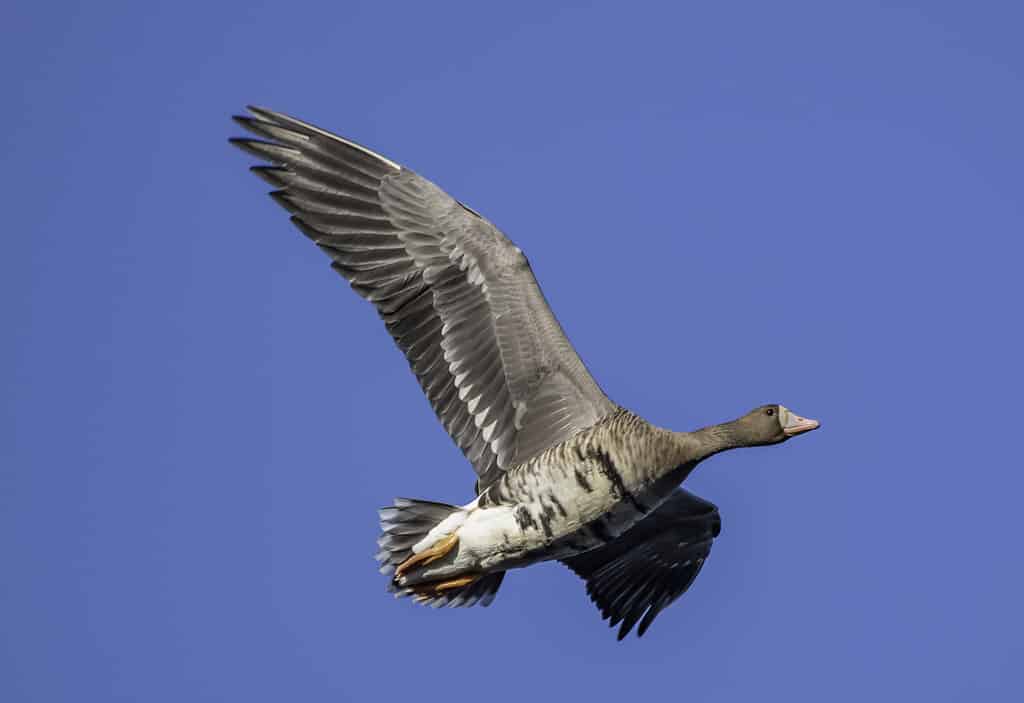
These geese are named for the white markings at the base of their bill.
©iStock.com/Supercaliphotolistic
9. Greylag Goose
The greylag goose (Anser anser) is known for its mottled grey and white plumage. These ducks have bright orange bills and pink legs. They are found throughout Europe and Asia. There are two different subspecies of the greylag goose. Although they are named for their separate regions, the two subspecies may also overlap.

Greylag geese are found throughout Europe and Asia.
©karegg/Shutterstock.com
10. Magpie Goose
As mentioned at the beginning of this article, the magpie goose is a bit unique when it comes to taxonomy. For most of the geese on this list, you’ll find that they are a part of the family Anatidae. However, this is not the case for the magpie goose.
The magpie goose (Anseranas semipalmata) is the only living species in the family Anseranatidae. This is a rather primitive family, with the species within emerging prior to other geese, ducks, and swans. They have a black and white plumage with yellow legs.
11. Nēnē (Hawaiian Goose)
The nēnē (Branta sandvicensis) is a species of goose endemic to the islands of Hawaii. Specifically, it is found naturally only on the Hawaiian islands of Oahu, Maui, Kauaʻi, Molokai, and Hawaii. It has been the state bird of Hawaii since 1957. It is known as the rarest goose in the world.
Its Hawaiian name, nēnē, comes from the bird’s call. They have a black head with brown and white buff bodies. It can survive everywhere, from coastal dunes to lava plains.

The nēnē is an endangered species on the Hawaiian islands.
©Christian Weber/Shutterstock.com
12. Lesser White-Fronted Goose
As mentioned further above, the lesser white-fronted goose (Anser erythropus) is related to the greater white-fronted goose. They live exclusively in Europe and Asia, with much of their migratory territory being found in Russia. They breed in the far north ranges of the continents, and they winter in the far south, such as in China. Occasionally, depending on the season, they may be found further west, such as in the United Kingdom.
The lesser white-fronted goose is around the same size as a mallard. It features the same white bill base as the greater white-fronted goose.
13. Pink-Footed Goose
The pink-footed goose (Anser brachyrhynchus) is common in the northern Atlantic Ocean. It breeds in the west, toward North America, and winters in the east, toward Europe. They mainly nest on cliffs so as to avoid predators, the most notable being the Arctic fox.
It is a medium-sized species with a black and pink bill, as well as a brown and white buff body.
14. Red-Breasted Goose
The red-breasted goose (Branta ruficollis) is a striking species. Its plumage is primarily black and white markings on the wings and face. However, what draws the eye is the rust-colored markings on their face and chest for which they are named.
A vulnerable species, their habitat is limited. They breed on the northernmost coasts of Russia, and they winter on the northern and western coasts of the Black Sea.
15. Ross’s Goose
The Ross’s goose (Anser rossii) sports a primarily white coat. However, it does have striking black wingtips that set it apart from other species, as well as a short neck. It is a protected species of least concern, although previous centuries of hunting once left this species with a smaller population. They have dark red legs that begin as grey when they are young before developing into this noticeable color.
Ross’s geese are found throughout North America. They breed on the far northernmost coasts of Canada and winter in Mexico, passing through much of the American Midwest in their migration.
16. Snow Goose
The snow goose (Anser caerulescens) is one species commonly confused for the Ross’s goose. This is because the snow goose has two morphs, a blue morph and one that is entirely white except for black wingtips. You can tell these two species apart by looking for the black “smile line” that the snow goose possesses. The blue morph of this species has a white head and a mainly dark body.
Snow geese are native to North America, although they are sparse in their populations. During the summer breeding months, they inhabit the far north coasts of Canada. During the winter, they will migrate south into Mexico and certain areas of the United States. This includes both the eastern and western coasts, as well as certain areas in the center of the country.
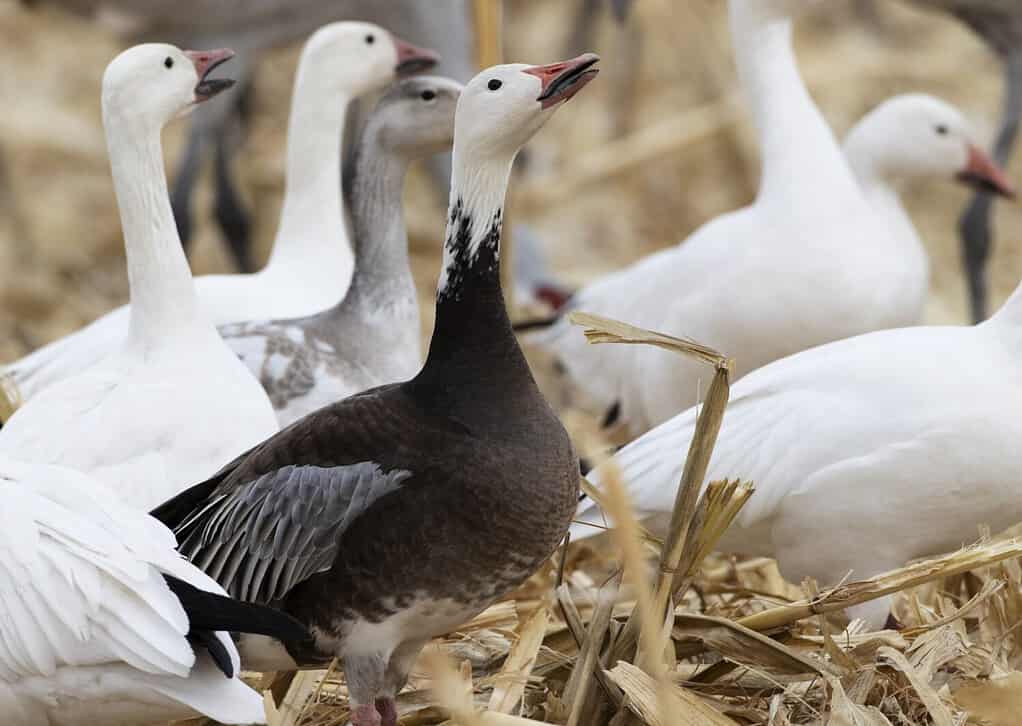
Snow geese have two morphs or colors.
©Florence-Joseph McGinn/Shutterstock.com
17. Spur-Winged Goose
The spur-winged goose (Plectropterus gambensis) is a large species of goose native to sub-Saharan Africa.
What is most interesting about this species is that some spur-winged geese may be toxic to consume. This is because these populations have a diet rich in poisonous blister beetles. This poison is known as cantharidin, and it can accumulate in the spur-winged goose’s tissues. As a result, consuming these birds can be dangerous, as a dose of 10 mg of cantharidin can be lethal.
They have dark brown-black backs with white chests and white markings on their face. Their bills and legs are red-orange.
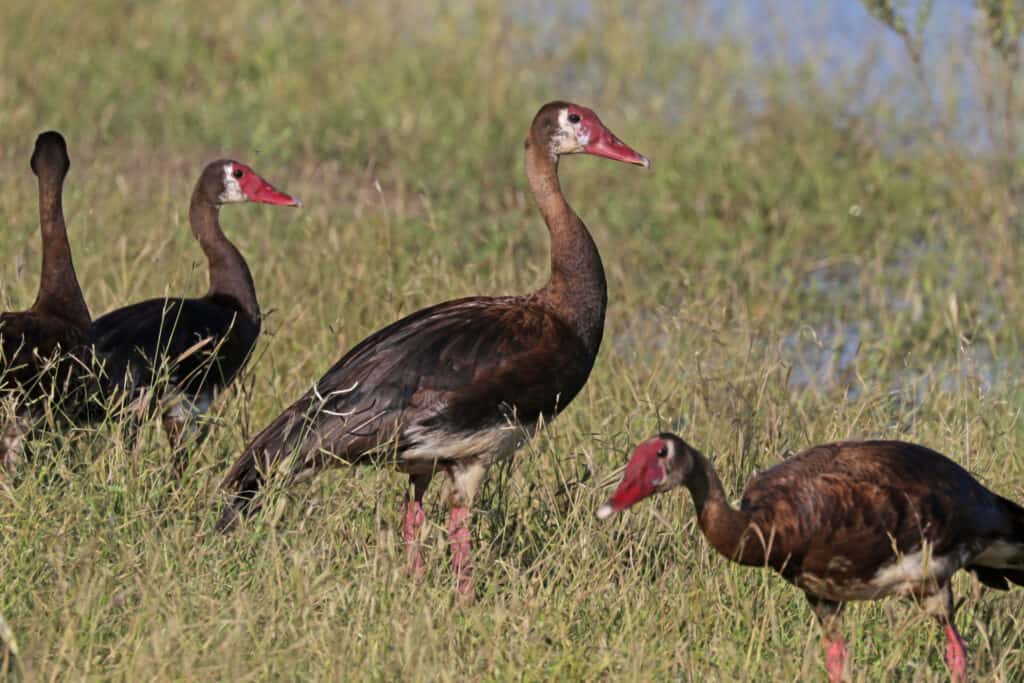
This impressive bird can reach a top speed of 88 miles per hour!
18. Swan Goose
Although its name may be confusing, the swan goose (Anser cygnoides) is, in fact, a species of goose and not a swan. It is a large species native to Eurasia. Of all types of geese in the family Anser, the swan goose is the second heaviest.
While its name may conjure images of white plumage and black bills, the swan goose doesn’t always resemble swans. While some are all white with yellow bills, others may have white and brown plumage, with notable white markings at the base of the black bill. Their legs are orange. It is a domesticated species of geese.
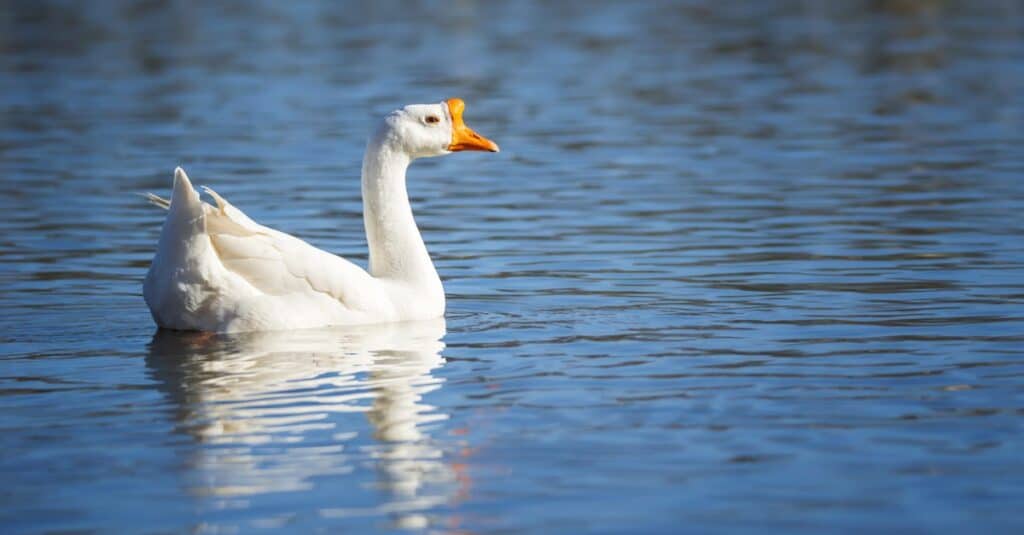
The basal knob on the top of its head is one of the most distinctive features of this breed.
©iStock.com/leekris
19. Taiga Bean Goose
The taiga bean goose (Anser fabalis) is often considered to be the same species as the tundra bean goose (discussed further below). However, certain organizations, such as the American Ornithological Society and the International Ornithologists’ Union, distinguish between the two bean geese.
Both sport a nearly identical appearance and range.
20. Tundra Bean Goose
The tundra bean goose (Anser serrirostris) is a closely related species to the taiga bean goose, often thought to be a single species. They breed in northern Siberia, and there are no common wintering grounds.
Like the taiga bean goose, the tundra bean goose has orange legs, brown and white plumage, and an orange and black bill.
The photo featured at the top of this post is © Tathoms/Shutterstock.com
Thank you for reading! Have some feedback for us? Contact the AZ Animals editorial team.







